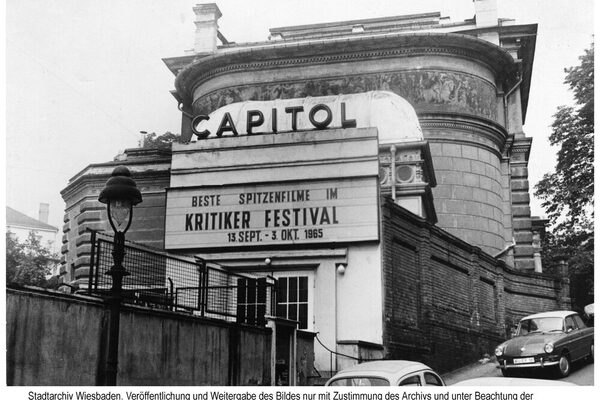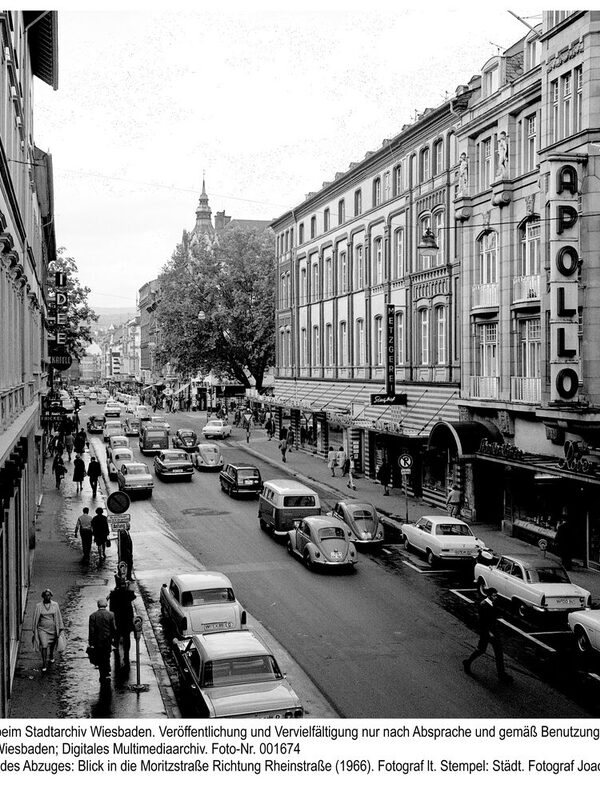Cinemas in Wiesbaden
Wiesbaden's first film screening took place on October 29, 1896 - just under a year after the first public projection of moving images in Berlin's Wintergarten variety theater by the Skladanowski brothers. Wiesbaden did not yet have its own theaters for the cinematograph either, whose premiere took place in the hall of the Plato Lodge at Friedrichstraße 27. In the following years, theater halls, restaurant side rooms and fairground stalls were used for the new medium, which initially only existed in an itinerant form. Compilations of short documentaries, slapstick interludes or so-called sound pictures were shown, in which well-known vocal arias were performed, with the sound coming from records coupled to the projector.
In addition to the traveling cinemas, which sometimes gave performances in front of several thousand spectators in converted circus tents (for example in Wiesbaden on an open space on the corner of Adolfsallee/Kaiser-Friedrich-Ring), more and more fixed cinemas were established in Germany from 1907 onwards. One of these opened in May 1907 at Rheinstraße 43 (later the Union Theater). This was followed shortly afterwards by the Auxetophon-Tonbild-Theater in Dotzheimer Straße and the Biophon-Theater in Wilhelmstraße, which had been integrated into the Hotel Monopol. By 1911, there were already five cinemas in Wiesbaden, including the Odeon-Theater (corner of Luisenstraße/Kirchgasse) and the Kinephon-Theater (later Capitol) on Kureck. Max Mack's film "The Other" was shown there in the autumn of 1913, an early example of developing European cinematic art and one of the first full-length films that gradually replaced the compiled programs of the early cinema stopovers, which were limited to a few acts. In the same year, the Thalia Theater was built at Kirchgasse 72. With 500 seats and elegantly furnished, it was considered Wiesbaden's largest and most comfortable cinema until the end of the First World War. The conversion of the Walhalla Theater into a movie theater in 1919 brought an improvement in this respect. It offered space for 1,400 spectators and became the city's most festive premiere cinema in the following years. In 1928, shortly before the end of the silent film era, it was upgraded with a Welte film organ.
In the 1920s and 1930s, Wiesbaden gained more screens: in December 1926, the Ufa im Park on Wilhelmstraße and in 1936 the Apollo on Moritzstraße. Its owner, Erich Ewert, had already opened the cinema for everyone in Bleichstraße, not far from today's Platz der Deutschen Einheit, in 1927. In the late 1930s, there were fourteen cinemas in Wiesbaden, at the end of the Second World War there were only six. After that, the number rose sharply: in 1950 there were 22, in 1955 even 32, which corresponded to a capacity of 15,500 seats. Cinemas destroyed during the war were rebuilt - such as the Neue Filmpalast on Schwalbacher Straße with its 1,000 seats, former theaters were converted (Residenz-Palast on the corner of Kirchgasse/Luisenstraße with 1,300 seats) or new cinemas were built, such as the Arkaden am Ring (800 seats).
In addition to established theaters, specialized theaters such as the Apollo showed the first 3D films from 1953, and in the same year a cinema for current affairs (Aki) opened in Langgasse, which projected newsreels and short films from 9 a.m. to midnight. Visitor numbers rose with the expanded offering: While there were around 2 million in 1938, ten years later there were already 3.2 million. The record of 5.8 million viewers was reached in 1956. This corresponds to an average of 23 movie admissions per year. This put Wiesbaden (although it only had 150,000 inhabitants) in seventh place in Germany at the time. With the increasing spread of television at the end of the 1950s, Wiesbaden cinemas also recorded declining revenues. In 1956-59, the number of movie admissions fell by almost a third from just under 5 million to 3.4 million.
The looming cinema crisis was also accompanied by a decades-long death of cinemas in Wiesbaden, to which most of the large theaters fell victim: The freestanding, neoclassical Capitol am Kureck (formerly Kinephon-Theater), which had emerged from an art salon in 1908 and had survived the destruction of the Second World War unscathed, had to make way for a high-rise office building in 1965, the Residenz-Palast for a department store extension, and the Neue Filmpalast for a parking garage. Existing movie theaters (such as the Thalia and the Apollo) were subdivided by the installation of smaller auditoriums or converted into so-called cinema centers. With the exception of the Bambi basement cinema, the third-generation Ewert film theater company now has a monopoly on Wiesbaden's commercial cinemas with eight screens in three buildings (as of 2016).
On the initiative of the German Film Institute (DIF), the archive cinema Caligari was opened in April 1980 - initially only in the gallery of the former Ufa im Park - and was later taken over by Wiesbaden's cultural department as a municipal cinema under the name Caligari FilmBühne. In 2009, Wiesbaden was given a new (studio) cinema in the form of the Murnau-Filmtheater, which shows repertoire films from the Friedrich Wilhelm Murnau Foundation 's collection of rights, among other things. Since 1984, Filme im Schloss has regularly shown selected films in Biebrich Palace.
Open-air cinemas are also very popular: the Bilderwerfer initiative has been organizing open-air film screenings in the Reisinger and Herbert grounds for several weeks every summer since 1998.

